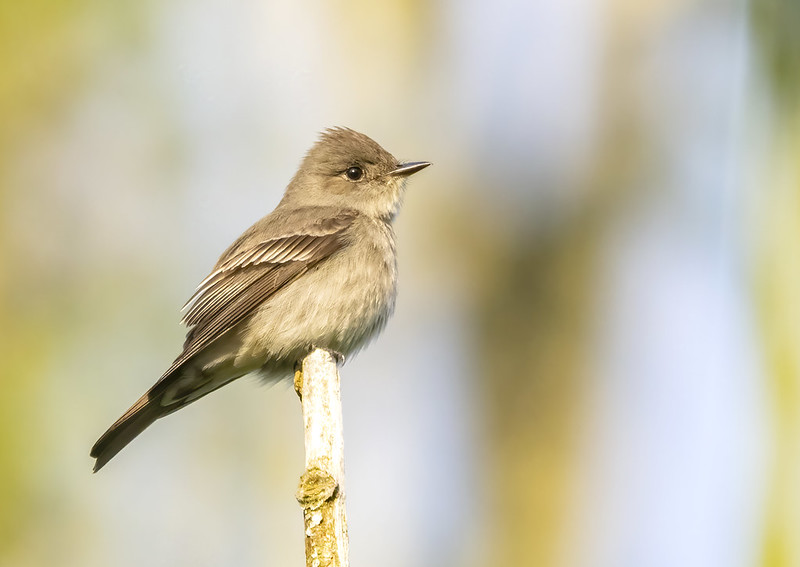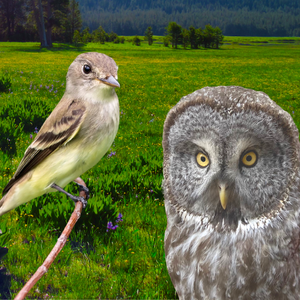Ever heard the old-fashioned saying “mad as a hatter?” The phrase has a sad origin. In the mid-19th century, when felted fur hats were all the rage, the felt was made using a solution containing mercury nitrate, and hat factory workers were exposed to high levels of it. Unfortunately, mercury is a neurotoxin and can cause symptoms including depression, irritability, hallucinations, loss of memory, lack of coordination, and tremors. And so many of the hat factory workers “went mad.”

A stream flows through a burned forest in the Plumas National Forest. Photo by Lora Tennant/USGS.
Mercury can be dangerous stuff, and not just for humans but wildlife as well. A recent study co-authored by IBP’s Executive Director and Research Ecologist Rodney Siegel looks at mercury levels in riparian birds and aquatic insects following forest fire in California’s Sierra Nevada. But how were these birds and insects exposed to mercury? And what do forest fires have to do with it?
When we think of mercury, many of us picture the mesmerizing silver liquid metal found in thermometers. This is pure, elemental mercury which rarely occurs naturally. Most mercury occurs in the form of chemical compounds in the Earth’s crust, such as mercury sulfide (also known as cinnabar.) It is also found in fossil fuels, in compounds such as mercuric sulfide in crude oil, and pyritic mercury in coal. It only becomes a problem for organisms when it’s released from the earth’s crust into the air or water. This occurs naturally during volcanic explosions, but since the Industrial Revolution, much more mercury has been released when fossil fuels- especially coal- are burned.

A Song Sparrow makes a meal of a mayfly. Photo by Kelly Colgan Azar.
Mercury easily vaporizes into a gas when mercury-containing compounds are burned. Once in the atmosphere, mercury can travel and be deposited in terrestrial and aquatic ecosystems, where it can form a variety of chemical compounds. The most concerning of these compounds is the neurotoxin methylmercury, which forms when microorganisms combine mercury with carbon. However, most of the emitted mercury is eventually sequestered in soil and vegetation in compounds that are much less harmful to animals. One of the biggest reservoirs of mercury is in the soils and vegetation of coniferous forests like those in the Sierra Nevada.
Scientists are still learning about the various pathways mercury can take as it cycles between the atmosphere, land, and water. Wildfires are an important pathway because when forests burn, the mercury sequestered in the trees and soils can be released into the atmosphere or washed into waterways in ash and destabilized post-fire soils. Once released, the mercury may encounter conditions where it can be converted into methylmercury and pose a hazard to wildlife and humans.
In a paper published earlier this year in the journal Ecotoxicology, lead author Garth Herring of the US Geological Survey along with Siegel and co-authors from IBP, the US Forest Service, the Nez Perce Department of Fisheries and Resource Management, and the Teton Raptor Center examine how wildfire severity affects mercury distribution in riparian food webs post-fire.

Mayflies were one of the groups of aquatic invertebrates sampled in this study. The larger photo by Katja Schulz shows a winged adult mayfly and the inset photo by Tom Koerner/USFWS shows the aquatic stage- a mayfly nymph.
The field portion of the study was conducted in 2015 on the Plumas National Forest in California’s Sierra Nevada where the Moonlight and Antelope fires burned in 2007. Stream water samples, aquatic invertebrates, and blood samples from riparian songbirds were collected at 19 sites within the fires’ boundaries that had burned at varying severities. Five additional unburned sites within the forest were also sampled. (Note: birds were mist-netted, banded, and blood samples collected under all applicable state and federal permits; birds were released unharmed.) Lab analyses measured methylmercury concentrations in invertebrates and total mercury in bird blood (95% of mercury in bird blood is in the form of methylmercury.)
Mercury concentrations in birds and invertebrates varied widely between species and foraging guilds (herbivore/predator for invertebrates and omnivore/insectivore for birds.) Focusing on birds, insectivores- especially flycatchers- had higher blood mercury levels than omnivorous birds. Western Wood-Pewees had the highest mercury levels of any bird species, 2.5 times higher than the next highest levels in House Wrens. Other studies have found higher mercury levels in Western Wood-Pewees than other songbirds. This suggests that these birds may target insect species with higher mercury levels- which in this study were predatory aquatic invertebrates like stoneflies. However, study leader Herring says that even the high mercury levels found in the pewees were likely not high enough to cause physiological impairment.

Study co-author Lora Tennant collects invertebrates from a small stream in the Plumas National Forest. Photo courtesy of Lora Tennant.
The relationship between fire severity and blood mercury levels in birds was inconsistent. Mercury levels in insectivores were not influenced by burn severity but levels in omnivores were negatively correlated with severity. There was no correlation between blood mercury levels in either insectivorous, or omnivorous, bird species and mercury levels in stream invertebrates. “The fact that we observed a relationship between burn severity and mercury levels in omnivorous birds but not in insectivorous birds may be linked to omnivorous birds' diet not being strictly aquatic in origin,” says Herring. “In this case, burn severity may be influencing terrestrial soil mercury and subsequently concentrations in terrestrial invertebrates.” When soils and vegetation burn, the mercury they contain is released into the atmosphere and higher-severity fires may leave less mercury in these terrestrial sources.
This study illustrates some of the complex pathways mercury can take through food webs and how wildfire can alter the distribution of this often harmful element. “I think it’s remarkable that even 8 years after the fires, we still observed evidence that burn severity was influencing mercury concentrations within riparian food webs,” says Herring. “What this makes clear is the critical role fires play in influencing the storage and redistribution of mercury in these landscapes.”





